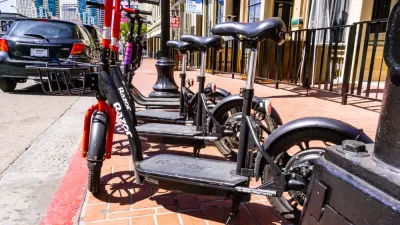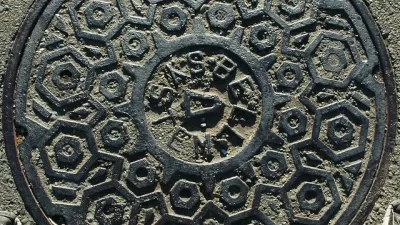Planners and designers should not be afraid to reclaim overused and misused words—as long as they know what they're doing.

The other day I got into a bit of a spat on Twitter with someone who had clearly had enough with the word "activate."
"Activate may be the worst planning jargon yet," cried the initial tweet.
A second tweet followed: "Seriously, students of planning, do yourselves a favor. Don't ever tell people you're activating their space."
That got me thinking about the years I spent working as the outreach coordinator for the College of Environmental Design at Cal Poly Pomona. While I was there, a group of students, representing the departments of Urban and Regional Planning, Landscape Architecture, Architecture, and Art, formed a club called the Space Activators.
In their spare time, the Space Activators dreamed up new ways to enjoy locations around campus. Some of these locations suffered the neglect of underuse, while others suffered the other kind of neglect that comes from overuse. The Space Activators created large works of public art by dragging and chalking a large expanse of gravel, exposing pattern and color to the upper floors of the nearby campus administration building. They threw Frisbees on vast, empty plots of grass. They inflated a 400-foot-long solar bag in the college's main public commons. They created a Facebook page to share ideas about how to activate off-campus spaces. In other words, they actively activated spaces.
Inspired by their work, and the concepts I learned from them, I found myself looking to other parts of campus, and other places I encountered in my life, with a new understanding of what makes them successful, fun, appreciated, and valuable. I also began to recognize, far too frequently, many places that were just the opposite.
I can't imagine telling those students to change the name of their organization because they'd used a "dirty word"—especially since they had done such a good job exemplifying and illustrating their concept.
The tweeted dissent toward the word "activate" exemplifies a reactionary tendency among people frustrated, understandably, with the conversation about planning, community, and design. I've also seen tweets prohibiting any use whatsoever of the passive voice as well as the use of the word "vibrant," which seems to be the world's favorite word to hate. There is clearly a lot of room for improvement in how we conduct these discussions about the future of the places where we live, work, and play. But think of such prohibitions as the dark side of the Force: quicker, easier, more seductive. They are also misleading and wrong.
That's not to say that planners are innocent of one of the great sins of language: employing empty phrases, inflated with self-importance and multiple syllables. Yes, buzzwords and cheap tricks of syntax like the passive voice are often the vessel for this sin. But don't blame the language for the proclivities of humans.
I am frequently reminded of advice shared by one of my favorite instructors from my own time as an undergraduate: "You can write anything you want, if it works." At the time, I knew this teacher was attempting to empower a room full of timid young writers, but now I invoke this advice as a sort of incantation against linguistic fear mongering. I can use "activate," if it works.
"Activate" automatically gets a head start because it's a verb, and verbs provide the driving power of language (my advice for improving communications always begins with better attention to verbs). Activate is also a commonly used verb, with a commonly understood meaning. "Activate" did not start its life in the language as jargon.
Activate, like so many other words used by planners, does not work when it's used as a substitute for unplanned or unconsidered specifics—when it's really just code for "I didn't do the work" or "I can't really say." It's not the fault of the word "activate" if someone didn't do the work or has chosen not to speak openly and honestly.
But when it's used to support specific examples, creative ideas, and honest dialogue, the word "activate" becomes code for something much larger and more powerful. The word activate becomes a project—an ambitious and diverse project, requiring collective and individual effort.
At this point, I have focused too much on one word, which by itself is not of life-or-death concern to the field of planning. The process by which planners choose their words, however, can make or break a project—large or small.
Planners (and many other political animals, for that matter) have perverted a large number of otherwise reliable and useful words by employing them as empty tools of misdirection. Vibrant, sustainable, walkable, mobility, engagement, and creatives come to mind. By all means, expect more from planners and politicians when they use words like these for the sake of appearances, rather than to describe a carefully considered plan.
But avoiding a word altogether also avoids the process of deciding why, when, and how it works. Knowing why, when, and how something works requires creative thought and careful evaluation. It requires planning.

Study: Maui’s Plan to Convert Vacation Rentals to Long-Term Housing Could Cause Nearly $1 Billion Economic Loss
The plan would reduce visitor accommodation by 25,% resulting in 1,900 jobs lost.

North Texas Transit Leaders Tout Benefits of TOD for Growing Region
At a summit focused on transit-oriented development, policymakers discussed how North Texas’ expanded light rail system can serve as a tool for economic growth.

Using Old Oil and Gas Wells for Green Energy Storage
Penn State researchers have found that repurposing abandoned oil and gas wells for geothermal-assisted compressed-air energy storage can boost efficiency, reduce environmental risks, and support clean energy and job transitions.

Private Donations Propel Early Restoration of Palisades Playground
Los Angeles has secured over $1.3 million in private funding to restore the Pacific Palisades playground months ahead of schedule, creating a modern, accessible space that supports community healing after recent wildfires.

From Blight to Benefit: Early Results From California’s Equitable Cleanup Program
The Equitable Community Revitalization Grant (ECRG) program is reshaping brownfield redevelopment by prioritizing projects in low-income and environmental justice communities, emphasizing equity, transparency, and community benefits.

Planting Relief: Tackling Las Vegas Heat One Tree at a Time
Nevada Plants, a Las Vegas-based nonprofit, is combating the city’s extreme urban heat by giving away trees to residents in underserved neighborhoods, promoting shade, sustainability, and community health.
Urban Design for Planners 1: Software Tools
This six-course series explores essential urban design concepts using open source software and equips planners with the tools they need to participate fully in the urban design process.
Planning for Universal Design
Learn the tools for implementing Universal Design in planning regulations.
Ascent Environmental
Borough of Carlisle
Institute for Housing and Urban Development Studies (IHS)
City of Grandview
Harvard GSD Executive Education
Toledo-Lucas County Plan Commissions
Salt Lake City
NYU Wagner Graduate School of Public Service





























